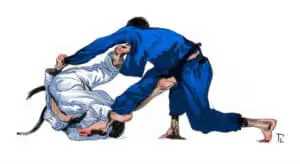
For many people who start BJJ their first goal is to achieve their blue belt which is natural as it is the first earned belt in Jiu Jitsu. A blue belt is a nice goal as it can be achieved in 1 to 2 years. BJJ athletes view earning their blue belt as a major milestone as they believe it signifies that they are no longer a beginner but how proficient is a blue belt really?
How Good Is A Blue Belt In Jiu Jitsu?
A blue belt in Jiu Jitsu is an intermediate practitioner with solid fundamentals. They should be able to easily submit and defeat untrained people close to their weight and also adequately defend themselves against larger untrained attackers.
Blue belt is the rank in BJJ with the most range of skills. You will come across blue belts that are terrible, that have little coordination and can barely perform a basic armbar. At the same time, you will come across blue belts who have been training since they were children and can give hobbyist black belts a run for their money.
Only at blue belt will you come across such a range of practitioners. This is based on the disparity in mat experience between some blue belts. You will find brand new blue belts who have only been training for a year and were not very athletic to start with. Then you will find blue belts who are close to their purple belt who have been training for 5 years, 6 days a week, and wrestled in high school.
If you rolled with these two different blue belts back to back in NoGi and didn’t know they were both blue belts you would swear that there was at least a 2 belt difference between them.
Blue belt is also strange because you have teenagers who have been training since they were little kids and have thousands of hours on the mat finally being old enough to earn their first adult belt. These blue belts are a nightmare and can often submit non competitive brown and black belts.
While there is a range of skill levels at blue belt there is a typical minimum skill level. A blue belt will usually have solid fundamentals. They will be comfortable in all the major positions in BJJ, guard, side control, mount, and back mount. They will know a number of techniques in every position including offensive and defensive moves.
A blue belt should have no problem toying with brand new white belts and untrained opponents both in the gym and in a street fight. A blue belt should have enough experience and technical prowess to quickly lock up a submission and end a fight quickly.
A blue belt should be able to defeat a bigger untrained opponent in a fight in the street or in the gym but it may be difficult and there is a chance they will lose. If they are up against significantly larger or highly athletic while they will be the favorite their chance of winning declines dramatically.
Once a BJJ practitioner reaches brown belt they should have no issues destroying a larger opponent in a fight no matter how much bigger than they are within reason.
What Is The Difference Between A Blue belt And A Purple Belt?
The difference between a blue belt and a purple belt is the number of techniques they know, the greater fluidity and speed with which the purple belt can move, and the overall deeper understanding of BJJ.
A purple belt’s body will be much more adapted to BJJ they will be able to react quicker and their instincts will be sharper allowing them to score more submissions, guard passes and sweeps.
A purple belt will just move better than a blue belt. They will be able to transition between different positions and cycle through techniques at a quicker pace than a blue belt. This can create more opportunities for them to score and submit their opponent.
It also helps that purple belts in general know more techniques than blue belts. I would estimate that purple belts probably know 30% more techniques than the average blue belt.
It isn’t just the number of techniques that separates a purple belt from a blue belt it is also the depth of the knowledge. A purple belt will be able to come up more solutions to problems they encounter on the mat than a purple belt. They will make less mistakes and their mistakes won’t be as pronounced.
